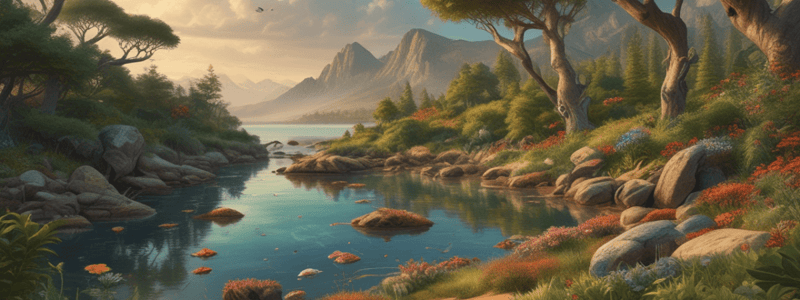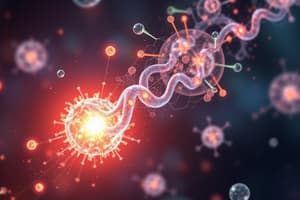Podcast
Questions and Answers
What does species richness refer to in an ecosystem?
What does species richness refer to in an ecosystem?
- The interaction between organisms and abiotic factors
- The number of individuals within a species
- The amount of energy produced by primary producers
- The total number of different species present (correct)
Which factor influences the primary productivity of an ecosystem?
Which factor influences the primary productivity of an ecosystem?
- Transition between different plant communities
- Interspecific relationships
- Abundance of tree species
- Amount of energy flow in the food chain (correct)
In terms of ecosystems, what is the ecological niche concept related to?
In terms of ecosystems, what is the ecological niche concept related to?
- The properties of a community
- The behavior of organisms within the habitat
- The interaction between organisms and abiotic environment
- The interspecific relationships between species (correct)
Which statement best describes matter and energy flow in ecosystems?
Which statement best describes matter and energy flow in ecosystems?
What is the relationship between primary productivity and population levels in an ecosystem?
What is the relationship between primary productivity and population levels in an ecosystem?
How does community composition change along a moisture gradient?
How does community composition change along a moisture gradient?
What causes greatly different plant communities on normal and serpentine soils?
What causes greatly different plant communities on normal and serpentine soils?
What is the key factor that determines the number of trophic levels in an ecosystem?
What is the key factor that determines the number of trophic levels in an ecosystem?
Which process results in the synthesis of new organic matter at each trophic level?
Which process results in the synthesis of new organic matter at each trophic level?
Why can't organisms recycle energy according to the text?
Why can't organisms recycle energy according to the text?
What is a critical characteristic of biodiversity for the survival of top consumers?
What is a critical characteristic of biodiversity for the survival of top consumers?
What is the metabolic process of converting non-gaseous compounds into gaseous compounds like ammonia known as?
What is the metabolic process of converting non-gaseous compounds into gaseous compounds like ammonia known as?
Which cycle involves the flow of matter from rocks to ocean sediment without a gaseous form?
Which cycle involves the flow of matter from rocks to ocean sediment without a gaseous form?
What term describes the rate at which organisms collectively synthesize new organic matter at each tropic level?
What term describes the rate at which organisms collectively synthesize new organic matter at each tropic level?
What type of symbiosis is exemplified by the relationship between bees and flowers?
What type of symbiosis is exemplified by the relationship between bees and flowers?
Which type of interaction exerts selective pressures or provides reproductive/survival advantages to a species?
Which type of interaction exerts selective pressures or provides reproductive/survival advantages to a species?
In terms of matter, is the Earth considered a closed or open system?
In terms of matter, is the Earth considered a closed or open system?
Which is a major source of inorganic carbon in aquatic ecosystems?
Which is a major source of inorganic carbon in aquatic ecosystems?
What is the main concern in the study of ecosystems?
What is the main concern in the study of ecosystems?
Which ecosystem process involves anaerobic respiration by methanogenic bacteria?
Which ecosystem process involves anaerobic respiration by methanogenic bacteria?
What does an aquifer consist of?
What does an aquifer consist of?
What is the major sink of organic carbon in aquatic ecosystems?
What is the major sink of organic carbon in aquatic ecosystems?
How does interspecific competition contribute to natural selection?
How does interspecific competition contribute to natural selection?
What is the fundamental niche of a species?
What is the fundamental niche of a species?
Which type of competition occurs when two species physically interact over access to resources?
Which type of competition occurs when two species physically interact over access to resources?
According to the Principle of Competitive Exclusion, what happens if two species are competing for a limited resource?
According to the Principle of Competitive Exclusion, what happens if two species are competing for a limited resource?
What happens to predator population sizes if there is uncontrolled predation?
What happens to predator population sizes if there is uncontrolled predation?
In the context of predator-prey relationships, what effect does providing shelter for prey have on their population dynamics?
In the context of predator-prey relationships, what effect does providing shelter for prey have on their population dynamics?
How do interspecific competition and resource partitioning relate to each other?
How do interspecific competition and resource partitioning relate to each other?
What ecological concept describes the species pattern differences in various localities based on their suitable conditions?
What ecological concept describes the species pattern differences in various localities based on their suitable conditions?
Study Notes
Ecosystems and Ecology
- Species seldom live alone and form ecosystems with other species in a habitat.
- An ecosystem involves organisms' behavior, interspecific relationships, interaction between organisms and the abiotic environment, matter, and energy flow.
Properties of Community
- Species richness: the number of species in an ecosystem.
- Primary productivity: the amount of energy produced, which determines population size.
Environmental Influence
- The environment influences species richness and primary productivity.
- Example: abundance of tree species along a moisture gradient, with a change in community composition.
Nitrogen Cycle
- Nitrogen sources: nitrates and ammonia.
- Nitrogen fixation: N2 → NH3.
- Nitrification: NH3 → NO3.
- Denitrification: NO3- / NH3 → N2.
- Nitrogen-fixing bacteria perform nitrogen fixation.
Phosphate Cycle
- Phosphate cycle has no gaseous form.
- Phosphate flows from rocks to ocean sediment.
Energy Flow
- Energy cannot be recycled due to entropy (the order of chaos).
- Organisms cannot convert heat energy into other forms of energy.
- The Earth functions as an open system regarding energy.
Flow of Energy in an Ecosystem
- Energy flows through tropic levels.
- Bacteria can be detritivores (decomposers).
Productivity
- Productivity: the rate at which organisms synthesize new organic matter.
- Gross primary productivity - cellular respiration = Net primary productivity.
- Each tropic level has its own productivity.
Biodiversity
- Biodiversity is crucial for the survival of top consumers.
- Diverse sources of species provide multiple food alternatives.
Symbiosis
- Symbiosis: elaborated, permanent relationships between two or more interacting species.
- Types of symbiosis:
- Mutualism: all interacting species benefit.
- Parasitism: one species benefits, the other is harmed.
- Commensalism: one species benefits, the other is not affected.
Interspecific Interaction and Natural Selection
- Interspecific interactions (competition, predation, parasitism, commensalism, and mutualism) exert selective pressures or provide reproductive/survival advantages.
Dynamics of Ecosystems - Matter and Energy
- Ecosystems: all living organisms in a particular place and their abiotic environment.
- Matter: a relatively closed system on Earth (no net output or input from the universe).
- Energy: an open system on Earth, constantly receiving sunlight.
Biogeochemical Cycles
- Carbon cycle
- Water cycle
- Nitrogen cycle
- Phosphate cycle
Carbon Cycle
- Major sources of inorganic carbon: atmospheric CO2, aqueous bicarbonate.
- Major sinks of organic carbon: organisms, fossil fuels.
- Terrestrial ecosystem: anaerobic respiration by methanogenic bacteria.
- Aquatic ecosystem: aquatic plants and phytoplankton.
Water Cycle
- Groundwater and aquifers: permeable, underground layers of rock, sand, and gravel saturated with water.
- Water table: accessible by plants and flows into streams.
Ecological Niche Concept
- Ecological niches: specific conditions in which a species grows best.
- Types of niches:
- Fundamental niche: entire range of physiological tolerance limits and resource needs.
- Realised niche: the niche a species can establish a stable population.
Competition
- Interspecific competition: occurs when two species use the same resource and there's not enough to satisfy both.
- Types of competition:
- Interference competition: physical interactions over access to resources.
- Exploitative competition: consumption of the same resources.
Predator-Prey Relationship
- Predator-prey relationships can lead to extinction of the predator if prey is over-consumed.
- Shelter can provide a balance between predator and prey populations.
Studying That Suits You
Use AI to generate personalized quizzes and flashcards to suit your learning preferences.
Related Documents
Description
Test your understanding of species interactions, ecosystems, community properties, and primary productivity in habitats. Explore the relationships between organisms and their environment in this quiz.




